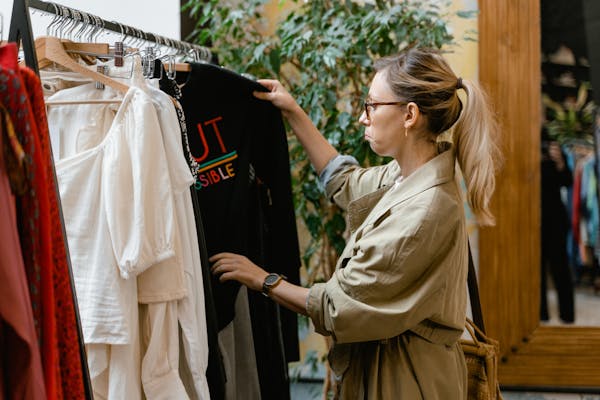Introduction: Why Sustainable Fashion Matters
The fashion industry has long been a symbol of creativity and style, but its rapid growth and consumption have come at a serious cost. Today, it’s one of the most polluting industries globally, contributing significantly to environmental degradation and unethical labor practices. As consumers become more aware of these issues, the conversation around sustainable fashion has gained momentum.
Sustainable fashion is more than just a trend; it’s a movement towards creating a more ethical, eco-friendly, and long-lasting fashion industry. In this article, we’ll explore five compelling reasons why it’s time to make the switch to sustainable fashion.
Reason 1: Reducing Environmental Damage
Fashion has a massive environmental footprint. From the production of fabrics to the transportation of garments across the globe, every step in the fashion supply chain contributes to environmental harm.
The Fashion Industry’s Carbon Footprint
One of the primary reasons to switch to sustainable fashion is its potential to reduce carbon emissions. The fashion industry alone is responsible for 10% of global carbon emissions—more than all international flights and maritime shipping combined. By choosing sustainable options, consumers can help reduce demand for fast fashion, which relies heavily on fossil fuels and energy-intensive processes.
Water Consumption and Pollution in Fashion
The fashion industry is notorious for its water usage, especially in the production of textiles like cotton and polyester. For instance, producing a single pair of jeans can use up to 2,000 gallons of water. Additionally, the chemicals used in dyeing fabrics contribute to water pollution, which can harm ecosystems and contaminate drinking water. Switching to sustainable fashion brands that use eco-friendly dyes and materials helps reduce the strain on water resources and prevent pollution.
Reason 2: Supporting Ethical Labor Practices
Fashion is not only about the environment; it’s also about the people behind the garments. Fast fashion often relies on exploitative labor practices in developing countries, where workers are paid low wages and forced to work in unsafe conditions.
Fair Wages and Safe Working Conditions
Sustainable fashion brands tend to focus on fair wages and better working conditions for their employees. By supporting these brands, you’re contributing to a more just and equitable industry, where workers are treated with respect and paid fairly for their labor.
The Importance of Transparency in the Supply Chain
Sustainability isn’t just about eco-friendly materials; it’s also about transparency. Ethical fashion brands often share detailed information about their supply chain, ensuring consumers know exactly where their clothes come from and how they were made. This transparency helps build trust and encourages brands to be more accountable for their impact on both people and the planet.
Reason 3: Longevity and Quality Over Quantity
In a world dominated by fast fashion, it’s easy to get caught up in the cycle of buying cheap, low-quality clothes that fall apart after a few washes. Sustainable fashion, on the other hand, focuses on longevity, quality, and timeless style.
Sustainable Materials: Built to Last
Sustainable fashion brands use high-quality materials that are designed to last longer. These materials—such as organic cotton, hemp, and recycled fibers—are not only better for the environment but also more durable. When you invest in well-made, sustainable clothing, you can wear it for years, reducing the need for constant replacements.
Slow Fashion: Moving Away from Fast Trends
Sustainable fashion encourages a shift away from fast fashion’s constant churn of trends. Instead of buying into the latest fleeting trend, slow fashion promotes a more thoughtful approach to style. By choosing classic, versatile pieces, you’re investing in a wardrobe that will stay relevant and functional for years to come, helping reduce unnecessary consumption.
Reason 4: Economic Benefits of Sustainable Fashion
While sustainable fashion might have a higher upfront cost, it often proves to be more economical in the long run. Here’s why.
Investing in Timeless Pieces
Sustainable clothing tends to be of higher quality, meaning you won’t need to replace it as frequently. Over time, investing in well-made pieces can actually save you money, as you’ll avoid the need to constantly buy cheap, disposable clothing.

Supporting Small and Local Businesses
By choosing sustainable fashion brands, you’re often supporting smaller, local businesses rather than large, corporate giants. Many sustainable brands prioritize local production, which not only ensures better working conditions but also supports the local economy. In addition, purchasing from small businesses helps create jobs and stimulates economic growth within communities.
Reason 5: Contributing to a Better Future
Switching to sustainable fashion isn’t just about making a change in your own life—it’s about contributing to a better future for everyone. Every purchase you make sends a message, and when you choose sustainability, you’re making a statement that you care about the world.
Reducing Waste: A Positive Impact on Landfills
The fashion industry is one of the largest contributors to waste globally, with millions of tons of clothing ending up in landfills every year. By choosing sustainable fashion, you’re helping reduce waste, as many sustainable brands focus on recycling and upcycling materials. Additionally, sustainable clothing is often designed with the end of its life in mind, meaning it can be reused or recycled instead of ending up in a landfill.
The Role of Consumer Choices in Creating Change
As consumers, we have the power to drive change. The more people demand sustainable options, the more the fashion industry will respond. Your purchasing decisions matter, and by supporting sustainable fashion, you’re helping to create a market for eco-friendly and ethical clothing. Together, we can push the industry toward more sustainable practices.
Conclusion: Make the Switch for a Better Tomorrow
The fashion industry has the potential to be a force for good, but it needs consumers to lead the charge. By choosing sustainable fashion, you’re not just protecting the planet—you’re supporting fair labor practices, encouraging high-quality, long-lasting clothing, and contributing to a more sustainable future. The time to make a change is now. It’s time to embrace sustainable fashion and make a positive impact on the world.
FAQs
1. What makes fashion “sustainable”?
Sustainable fashion focuses on using eco-friendly materials, ethical labor practices, and production processes that minimize environmental damage. It also emphasizes longevity and reducing waste.
2. Is sustainable fashion more expensive?
While sustainable fashion may have a higher upfront cost, it is often more durable, saving you money in the long run by reducing the need for frequent replacements.
3. How can I find sustainable fashion brands?
Look for brands that use eco-friendly materials, provide transparency about their supply chain, and prioritize ethical labor practices. Many brands also offer certifications like Fair Trade or Global Organic Textile Standard (GOTS).
4. Can I still follow trends with sustainable fashion?
Yes! Sustainable fashion focuses on timeless pieces that can be worn year-round, but it also embraces slow fashion, which means fewer, more meaningful purchases rather than constantly chasing fleeting trends.
5. How can I reduce waste in my fashion choices?
Opt for quality over quantity, buy secondhand clothing, and recycle or donate garments you no longer wear. Supporting brands that prioritize recycling and upcycling can also help reduce fashion waste.

